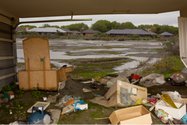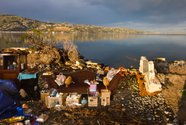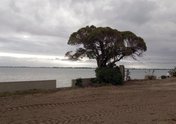John Hurrell – 14 May, 2021
These coloured images are all part of the Wallace Collection. They feature earthquake-damaged properties that were abandoned and then cleared. They showcase various degrees of sunlight on severely destroyed domestic architecture, overgrown landscape, and receding choppy water. Also opened boxes of abandoned household goods. Items of furniture. Nature (in the form of sand and unruly marram grass) has taken over.
Auckland
Jane Zusters
Te Karoro Karoro: A Place Called Home: The Red Zone Clearances: Christchurch Ōtautahi
14 April - 30 May 2021
Up on the first Pah Homestead floor, in the photography gallery, Jane Zusters presents seventeen photographs from 2011-16, taken in the Bexley /Southshore part of Christchurch Ōtautahi, around the base of the Rockinghorse Rd spit that guards the entrance to the Estuary.
These coloured images are all part of the Wallace Collection. They feature earthquake-damaged properties that were abandoned and then cleared. They showcase various degrees of sunlight on severely destroyed domestic architecture, overgrown landscape, and receding choppy water. Also opened boxes of abandoned household goods. Items of furniture. Nature (in the form of sand and unruly marram grass) has taken over.
In the gallery the main wall displays Te Karoro Karoro (2011-2016)—three columns of five photos each (mounted on wide vertical cardboard strips)—and on the wall opposite you can see two framed images under glass: a shot of a tree hut (Supply a place called home: redzone clearances: Christchurch (2016)); and Zusters’ own original childhood family house (At home Wetlands Grove, Bexley (2013).
There are some interesting surprises within Zusters‘ images. They are not what they seem at first glance. For example, you may remember Martha Rosler the American activist feminist artist? She is famous for in the seventies creating photographed black/white architectural interiors, where a bourgeois sitting room, kitchen or bedroom’s large plate glass window had violent images of social unrest, famines or Vietnam spliced in between its drawn curtains. A stinging critique of American global apathy.
In two works (at home Wetlands Grove...; and the top right image of the Te Karoro Karoro grid) Zusters has done something similar compositionally, but you have to mentally recreate the floorplan of the interiors (follow the perspectival lines of the walls you can see) to notice that something is odd. Your first immediate thought is that the main wall in each photograph has been taken away because of earthquake damage, opening the building up to the elements. Not that Zusters has photoshopped in an ‘unnatural’ image from elsewhere.
This is what she might have done with a photo featuring a spread out, bright pink bed cover, and scattered domestic objects, where the ingredients (because of their colour) seem disparate, but apparently not. The fragmented spots of sunlight give everything they touch a peculiar supernatural glow, an unexpected intensity. The chroma is utterly fabulous.
With the strange ‘invisible wall’ works, we feel we are looking out from within three walled boxes, sitting in lounges with the sea breeze whistling through our hair.
Another image shows the artist with her camera, caught in a leaning mirror and peering in through a shut window from outside—into an empty house. However the angle seems strange. The reflection doesn’t seem authentic.
This is a great show of Zusters photos, but using a grid method on one wall, presenting images crammed together or raised too high does them no good. They need to be spread out, isolated at eye height and framed. So you can effortlessly ponder issues like those I have just described. The presentation is half-arsed.
It is brilliant work nonetheless—but tricky to look at properly. The individual photos are haunting, sensual, and infused with glorious light. Well worth a trip to the Pah.
John Hurrell














 Two Rooms presents a program of residencies and projects
Two Rooms presents a program of residencies and projects Advertising in this column
Advertising in this column



This Discussion has 0 comments.
Comment
Participate
Register to Participate.
Sign in
Sign in to an existing account.